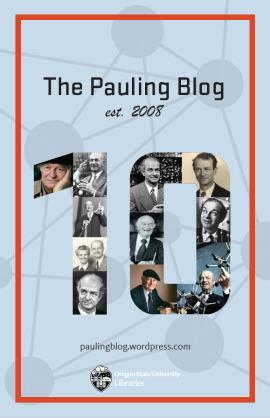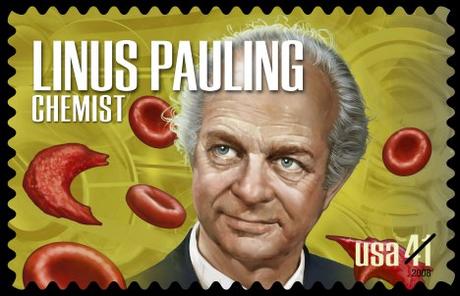
[Over the next four weeks, the Pauling Blog will celebrate its tenth anniversary by sharing extracts from an oral history interview conducted with Chris Petersen, the founder, editor and publisher of the blog. This interview was led by Tiah Edmunson-Morton, who is an archivist and instructor, and also the curator of the Oregon Hops and Brewing Archives, a component of the Special Collections and Archives Research Center at Oregon State University Libraries, which is likewise home to the Pauling Papers and the Pauling Blog. The transcript extracts presented here have been lightly edited for clarity. Click here to view the full interview.]
Tiah Edmunson-Morton: Tell me the story of how the Pauling Blog started.
Chris Petersen: Well, the origin story of the Pauling Blog would precede the blog itself by several years.
So I started working in Special Collections in 1996 and, at that point, there was a strong interest in digitization already. The Pauling Papers had been at OSU for about ten years, kind of/sort of. Pauling made his donation in 1986, he lived until 1994. Over the course of that time, maybe twenty percent of the collection showed up and a smaller portion of that was jammed into a very small space in the old Kerr Library – a space that doesn’t exist anymore. But the part that we had mostly was not in that space; it was in a couple of other places outside of the library and was basically just in storage. And then Pauling died in ’94, it took about two years to resolve the estate, so around ’96 is when most of the stuff came. And then ’98 is when the facility that we’re in now was completed, and that’s when things came under one roof for the first time.
During that period of time, from ’86 to ’98, we had the stuff that we had and we were processing it as well as we could. And during that time, the library was very interested in doing some sort of digitization project. And so they settled on something called LaserFiche, which was a database-driven piece of software that was fairly slick. It allowed you to create a folder structure online that looked similar to what we might see in Windows Explorer now, and then digitize stuff into those folders and make it available. It could be password-protected if you wanted. And that’s how people would access the content online.
So that was something that was being pursued with gusto and press announcements went out, “we’re digitizing this, isn’t it great?” And it was, sort of. But there were a couple of problems. Number one, we started digitizing before the collection was here – never a good thing. So the collection was being processed and re-processed as time was moving forward, and this directory structure that we were creating was no longer relevant. So things got pretty messy in a hurry.
The other thing that happened was copyright: the Digital Millennium Copyright Act was passed and put us in a situation where we could provide access to everything that we held the copyright for, which was all of Pauling’s writings, but not all the other things in the collection that weren’t his writings which, there’s a lot of that. So that project kind of fell apart as a result of that.
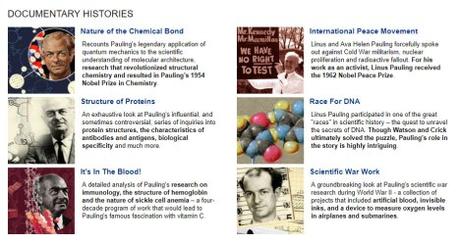
There was still an interest in digitizing though, and so from there we switched into thematic websites, which is what is represented now — particular aspects of Pauling’s life and career represented through these documentary history websites mostly, but also through some more traditional kinds of digital collections that were created over time as well. So that was a big point of emphasis for Special Collections from really the beginning of my association in ’96 to, well, for the entire duration of the department, which ended in 2011.
TEM: At that point was it pretty standard or traditional for archives that focused so much on one person to digitize that much content? Or have that robust of a website, period?
CP: I doubt it. I think that we were different in a lot of ways. I think that probably there weren’t that many archives that focused on one person. We technically didn’t, we had about a dozen other collections, but they were all quite a bit smaller than the Pauling Papers.
But the library was very invested in innovation and developing a digital presence – that was a very big part of our identity as a library – and Special Collections was a big part of making that come to fruition. So there was an emphasis on that administratively, and we wanted to do it too within the department. We also were well-equipped to do it. I mean, I didn’t have a whole lot of technical skill when I started working, but [Analyst Programmer] Ryan Wick definitely did. He’s still with us and he was the driving force on the technical end. And I was a useful helper as far as that’s concerned and learned things, and he and I have been a good partnership over the years in that regard.
Anyway, this is a very long way of getting to the Pauling Blog, but… So we did all these websites and they were what they were, and they got used and we were proud of them. We were pretty obsessed with our Google ranking for a while and so that was one piece of how the Pauling Blog came about – I’ll tell that story in a second. We also had a need to tell people about events that we were participating in or hosting. And the solution we had was basically a little spot on our website and an RSS feed that would shoot out, that maybe people would use, probably not a lot of them. And that was our “something’s happening,” if you happened across our website you might find out about it, if you subscribed to our RSS feed you might find out about it.
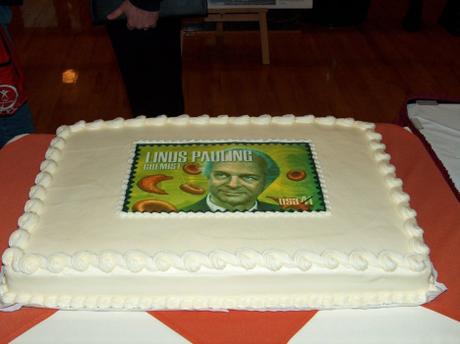
So we wanted something better for a particular event and that was the release of a postage stamp. In March 2008, the Postal Service released a series of stamps celebrating American scientists, and Pauling was one of them. And they had an event in the basement of the Memorial Union, they had a cake, and Linus Pauling Jr. came, and students from Linus Pauling Middle School came, and all the local stamps geeks showed up, and it was great. It was actually fun – it was great.
But anyway, this was happening and we wanted to let people know it was going to happen, and we wanted a better way to do it than what we had from our website and our RSS feed. We also wanted to be able to follow up; we wanted to take pictures, we wanted to make them available somehow. And this was pretty early on in terms of photo sharing, etc. We definitely didn’t have a Flickr account or anything like that.
So I was thinking about this and I talked about it with a student of ours – Trevor Sandgathe, whom you and I know well, he’s still on staff [as Public Services Archivist] – and we talked about creating a blog. And the blog would be a place where we could be more flexible with telling stories about Pauling, but also raising awareness about events like this. That’s really how that piece of it got motivated.
But the other bit was the Google ranking. And so we would do a lot of searching for “Linus Pauling” and we got frustrated because we learned pretty quickly that, at that time – I’m sure things have changed since – but at that time, Google would lump everything that we had ever made about Linus Pauling into one pot, basically. And so you would search for “Linus Pauling” and you would get the documentary history website that was the most popular, which was Nature of the Chemical Bond, and you wouldn’t have any indication that all this other stuff existed. If you did the “Linus Pauling” search, you wouldn’t have Nature of the Chemical Bond, International Peace Movement, Proteins website, etc. All you’d have is Nature of the Chemical Bond. And if you clicked on “more results within domain,” then that’s when that other stuff would start to appear.
So essentially we were burying ourselves within our domain; we were getting this one return. The only way you would ever find anything else was if you did “Linus Pauling” plus some other word to get into that other chunk of stuff that we had put up online.
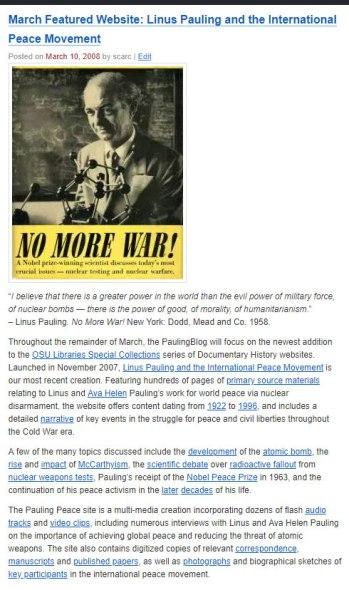
So we started to think about that, the fact that we were burying ourselves in our own domain, and we thought, “wouldn’t it be interesting if we had a different domain that we controlled that we could use to funnel traffic into these other resources?” So essentially what were trying was a very rudimentary approach to search engine optimization. That was another goal of the blog – unstated, but certainly it was.
So if you look at those early blog posts, we have the stamp announcement and the follow-up. But we also have a series of short posts that are very link-heavy, that essentially are retelling stories that had already been told on the documentary history websites. But the thought process was that eventually the Pauling Blog would raise up in rank in Google and that people would come across this content in the Pauling Blog, and they would click on the links, and that would get them into the stuff that was within the Special Collections domain. And that – I don’t know if it ever actually worked, but those were the two reasons why the Pauling Blog came into being. That’s the origin story.
